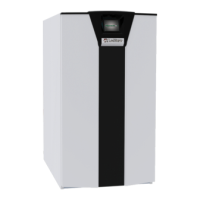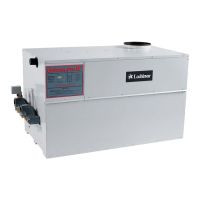18
1 Service (continued)
Control modes
BMS Thermostat Input
When controlling the water heater through the 0 - 10V BMS
input or through ModBus, the water heater can be enabled one
of two ways. With the BMS Thermostat Input parameter set to
ACTIVE, the water heater will be enabled by closing the tank
thermostat input. When set to INACTIVE, the water heater
will be enabled by the voltage level on the 0 - 10V input (in the
case of 0 - 10V BMS control), or the 0 - 10V input value received
through ModBus. The default value is INACTIVE.
BMS
The set point or modulation of the water heater may be
controlled through the 0 - 10V BMS input or through ModBus.
When the BMS parameter is set to INACTIVE, the 0 - 10V
input will be ignored. When set to ACTIVE, the set point or
modulation will be controlled by the voltage on the 0 - 10V
input (in the case of 0 - 10V BMS control), or the 0 - 10V
input value received through ModBus. The default value is
INACTIVE.
ModBus
When BMS is set to ACTIVE (see BMS) and the water heater
is being controlled through ModBus, set ModBus parameter to
ACTIVE. Otherwise, set the ModBus parameter to INACTIVE.
Note that the water heater can still be monitored by ModBus
with this parameter set to INACTIVE. The default value is
INACTIVE.
ModBus T/O
The ModBus T/O is the amount of time the unit controls will
wait to receive a communication string from the BMS controller
before reverting back to its own internal parameters. This
parameter is adjustable by the installer by accessing the ModBus
T/O parameter. The adjustment range of this parameter is 5
seconds to 2 minutes. The default value is 10 seconds.
Cascade Address
The water heater designated as the Leader needs to be
programmed with address 0. All the Member water heaters
require addresses from 1 to 7, and the addresses must be
different for each Member. The addresses can be in any order,
regardless of the order in which the units are wired together.
This parameter is adjustable by the installer by accessing
the Cascade Address parameter. The tank sensor must be
connected to the Leader water heater. The default address is 1.
Cascade Type
There are two (2) options for the way a Cascade divides the
load between its heaters. The first is Lead/Lag, designated as
L/L in the menu. This method is used when it is desired to
have the least amount of total flow through the water heaters.
This method will modulate the last two (2) water heaters.
This provides for smooth transitions when a water heater
turns on or off. When the last water heater reaches 100%
and the calculated load is still increasing, it will start the next
water heater at 20% and reduce the previous water heater to
80%, thus eliminating the sudden jump in total output of the
Cascade. When the calculated load is decreasing and the last
water heater gets down to 20% fire, it will hold it there and
start lowering the firing rate on the next-to-last water heater.
When the next-to-last water heater reaches 20%, it will turn the
last water heater off and raise the rate of the next-to-last water
heater to 40%, thus eliminating the sudden drop in total output
of the Cascade.
The other Cascade divider method is Efficiency Optimization,
designated as EFF in the menu. This method is used, as the
name implies, when it is desired to have the most efficient
system. When the first water heater reaches a certain rate
(default = 90%), it lowers its rate to 45% and turns on the next
water heater at 45%. The two (2) water heaters then modulate
at the same rate.
As the calculated load increases further and both water heaters
ramp up to 90%, it lowers the rate of the first two (2) water
heaters to 60% and brings the next water heater on at 60%.
The three (3) water heaters then modulate together. As the
calculated load decreases, the water heaters will reach a lower
threshold (default = 30%), at which time the last water heater
(the third in our example) will turn off and the Cascade will
increase the rates of the remaining water heaters to provide the
equivalent total output as before ((3 x 30%) / 2 = 45% in our
example).
Efficiency optimization is automatically selected when heaters
of different sizes are programmed into the Leader water heater
(see Cascade Member Size Screen on page 20).
Service Manual

